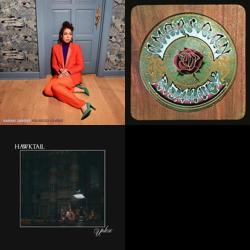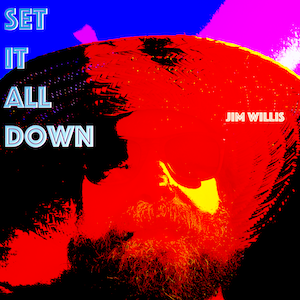Morning after update to 15.4, all shortcuts look the same now. Not super useful, Apple:

-
Thanks, update!
-
Path Less Pedaled + Grant Peterson
Russ and Grant! I love this video/interview. I wish it were a full hour!
There are so few people (especially out here in NJ) that share Grant and Russ’ view of cycling or even try to understand it but, man, they are speaking my language.
-
Windy Winter Remains
-
Troubleshooting WordPress Share to Mastodon plugin
I uploaded an image to a WordPress post using three different techniques, and you can see the way they appear in Mastodon in the image below using this really excellent and customizable/flexible plugin.

I’m trying to get the image to appear like it does when uploading to a Mastodon post using the native posting tool, like this:

-
PESOS vs POSSE
I didn’t realize Dries founded/manages Drupal until I checked out the about page on his website. In any case, he has a really excellent comparison of PESOS vs POSSE on his site.
For me, I’m just trying to find as friction-free a way to collect/post/share. After a bunch of false starts I’m leaning towards WordPress as the bucket that collects everything and sends it out to other places like Mastodon, my newsletter and Day One (my journal software).
Unfortunately, iOS shortcuts integration with WordPress is horrible. Unless you fall back to old school xml-rpc stuff which feels like way too much work. This means it’s not a totally friction-free collection bucket but I feel like from a sharing-out perspective, it’s the right tool for the POSSE job.
-
Martin D-18 with d-gard tone-gard
A friend unexpectedly gifted me this the other night when we were rehearsing for an upcoming gig. I can not believe what a huge difference it makes in the sound/volume of my already very loud Martin D-18.
It’s called a d-gard and is purpose built for the back of a Martin dreadnaught. I put some new felt on it so that it wouldn’t scratch the finish. I’m astounded at how much more volume and sustain I’m getting from this. A good friend of mine who plays mandolin has been telling me to get one of these for years and I’m glad I finally got one. For standing up and playing at live gigs around a single mic, I’m hoping this gives me the volume I need.

-
When you sit down to learn Norman Blake’s New Chance Blues and just keep clicking though on the jams:
https://ift.tt/tqbuJ6R
-
Love the mix of drum machine and live drums on this track:

-
Man, I have got my music streaming dialed in using Marvis. Combining tracks from a bunch of playlists, applying some filters and sorting. Just saying.
-
Indie Microblogging
This:
Massive centralized platforms create problems for society. By posting to your own site, you control your content, distributing it more evenly across the web and minimizing the power of big tech companies.
and
Temporary, viral movements like #DeleteFacebook are not enough. We need something sustainable that permanently changes the narrative.
Both from Manton Reece’s excellent Indie Microblogging.
Our high-schools should have a whole class built around this book. It would teach kids how to take action, how to not be powerless. From understanding ownership of content to understanding the way the Internet runs on open standards. It’s all in here.
I’ve never pre-ordered a book so quickly.
Current Spins


Check out my album Set It All Down on your favorite streaming service.
Posts Worth Reading:
Letterboxd
- Couldn’t finish this one. Not bad, just not what we needed at the moment.
- Looking for a comedy, this wasn’t but it did treat a tough topic in an accessible way. Still, not funny especially in light of our current political climate.
- Great spy movie, loved the style and story.
- (date approximate)
- (date approx)
- I love a frame tale and this one is spectacular
- Amazzzzzzing. Nothing like it.
- On location India footage was transportive.
- so much unexpected happening here. Perfect New Year’s Eve movie.
- Jude Law. Wow. Powerful storytelling. Must see.
Reading Notes
- Who profits from our constant state of dissatisfaction? The answer, of course, is painfully obvious. Every industry that sells a solution to a problem you […]
- the shifts have been in place for awhile. A certain kind of book—say those reviewed in the NYRB—will become like opera, or theater, or ballet, […]
- • No more struggle: “Whatever arises, train again and again in seeing it for what it is. The innermost essence of mind is without bias. […]
- The real problem, in my mind, isn’t in the nature of this particular Venture-Capital operation. Because the whole raison-d’etre of Venture Capital is to make […]
- . The EU invokes a mechanism called the precautionary principle in cases where an innovation, such as GMOs, has not yet been sufficiently researched for […]
Saved Links
- March 2025
- February 2025
- January 2025
- December 2024
- November 2024
- October 2024
- September 2024
- August 2024
- July 2024
- June 2024
- May 2024
- April 2024
- March 2024
- February 2024
- January 2024
- December 2023
- November 2023
- October 2023
- September 2023
- August 2023
- May 2022
- April 2022
- March 2022
- February 2022
- January 2022
- December 2021
- October 2021
- July 2021
- June 2021
- January 2021
- December 2020
- November 2020
- October 2020
- September 2020
- August 2020
- July 2020
- April 2020
- March 2020
- February 2020
- January 2020
- December 2019
- November 2019
- October 2019
- September 2019
- August 2019
- June 2019
- May 2019
- April 2019
- March 2019
- January 2019
- June 2018
- March 2018
- February 2018
- November 2017
- October 2017
- August 2017
- February 2017
- August 2016
- December 2015
- July 2015
- March 2015
- February 2015
- January 2015
- December 2014
- November 2014
- March 2014
- February 2014
- September 2013
- August 2013
- July 2013
- June 2013
- May 2013
- April 2013
- March 2013
- February 2013
- December 2012
- June 2012
- January 2012
- February 2010
- January 2010
- December 2009
- September 2009
- August 2009
- July 2009
- June 2009
- May 2009
- April 2009
- March 2009
- February 2009
- January 2009
- December 2008
- November 2008
- October 2008
- September 2008
- August 2008
- July 2008
- June 2008
- May 2008
- April 2008
- March 2008
- February 2008
- January 2008
- December 2007
- September 2001
- May 2001
- February 2001
- January 2001
- September 2000
- June 2000
- May 2000
- November 1999
- September 1998
- June 1998
- May 1998
- September 1997
- February 1997
